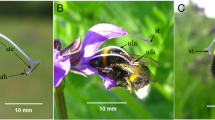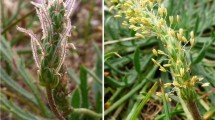Abstract
Sexual allocation pattern is considered highly relevant for the maintenance of females in the process of evolution from hermaphrodites to dioecy. Theoretical and empirical studies predict that gynodioecious plants should invest more resources in male function under harsher environments and/or when female frequency is higher; and that there are trade-offs between male and female function. We studied sexual allocation pattern in the gynodioecious species Cyananthus macrocalyx in two populations in SW China. The results showed that although the total flower mass in hermaphrodites was significantly higher than that in females, females and hermaphrodites allocated similar biomass to female function (pistil biomass). As a consequence, females allocated relatively more resource to female function, while hermaphrodites allocated relatively more resource to pollinator attractiveness. There was no difference in total flower mass, pistil mass, and pollen production in hermaphrodites between the two populations. These results suggest that the females compensate for the disadvantage of lacking male function by allocating relatively more resource to female function, while hermaphrodites gain fitness through both male and female functions. This study supports the idea that if females are to be maintained in a gynodioecious population, they must allocate more resource to female functions than is necessary for hermaphrodites. However, our results were in contrast to those of previous studies, in that trade-offs between male and female functions and male-biased allocation under high female frequency were not observed. This study adds to the body of research on plant sexual allocation, and for that it is, at least at some aspects, contrary to previous statements, it could be helpful for advancing the theoretical predictions in the future.




Similar content being viewed by others
References
Alonso C, Herrera CM (2011) Back-and-forth hermaphroditism: phylogenetic context of reproductive system evolution in subdioecious Daphne laureola. Evol Dev 65:1680–1692
Arnan X, Escola A, Rodrigo A, Bosch J (2014) Female reproductive success in gynodioecious Thymus vulgaris: pollen versus nutrient limitation and pollinator foraging behaviour. Bot J Linnean Soc 175:395–408
Arroyo MTK, Primack R, Armesto J (1982) Community studies in pollination ecology in the high temperate andes of central Chile. 1. Pollination mechanisms and altitudinal variation. Am J Bot 69:82–97
Ashman TL (1994) Reproductive allocation in hermaphrodite and female plants of Sidalcea oreganas sp. spicata (Malvaceae) using 4 currencies. Am J Bot 81:433–438
Ashman TL (1999) Determinants of sex allocation in a gynodioecious wild strawberry: implications for the evolution of dioecy and sexual dimorphism. J Evol Biol 12:648–661
Ashman TL, Baker I (1992) Variation in floral sex allocation with time of season and currency. Ecology 73:1237–1243
Ashman TL, Stanton M (1991) Seasonal-variation in pollination dynamics of sexually dimorphic Sidalcea-oreganas sp. spicata (Malvaceae). Ecology 72:993–1003
Baker AM, Burd M, Climie KM (2005) Flowering phenology and sexual allocation in single-mutation lineages of Arabidopsis thaliana. Evolution 59:970–978
Bateman AJ (1948) Intra-sexual selection in Drosophila. Heredity 2:349–368
Bawa KS, Opler (1975) Dioecism in tropical tress. Evolution 29:167–179
Bawa KS (1980) Evolution of dioecy in flowering plants. Annu Rev Ecol Syst 11:15–39
Bazzaz FA, Reekie EG (1985) The meaning and measurement of reproductive effort in plants. In: White J (ed) Studies in Plant Demography: A festschrift for John L Harper. Academic Press, London, pp 373–387
Bloom AJ, Chapin FS, Mooney HA (1985) Resource limitation in plants—an economic analogy. Annu Rev Ecol Syst 16:363–392
Burd M, Head G (1992) Phenological aspects of male and female function in hermaphroditic plants. Am Nat 140:305–324
Charlesworth B, Charlesworth D (1978) A model for the evolution of dioecy and gynodioecy. Am Nat 112:975–997
Charlesworth D, Charlesworth B (1981) Allocation of resources to male and female functions in hermaphrodites. Biol J Linnean Soc 15:57–74
Charlesworth D, Morgan MT (1991) Allocation of resources to sex functions in flowering plants. Philos Trans R Soc B-Biol Sci 332:91–102
Charnov EL (1982) The theory of sex allocation. Princeton University Press, Princeton
Chen JG, Yang Y, Zhang ZQ, Niu Y, Sun H (2013) A nodding capitulum enhances the reproductive success of Cremanthodium campanulatum (Asteraceae) at high elevations in the Sino-Himalayan Mountains. Plant Ecol Divers 6:487–494
Cruden RW (1977) Pollen-ovule ratios—conservative indicator of breeding systems in flowering plants. Evolution 31:32–46
Cruden RW (2000) Pollen grains: why so many? Plant Syst Evol 222:143–165
Darwin CR (1877) The different forms of flowers on plants of the same species. John Murray, London, p 279
Delph LF (1996) Flower size dimorphism in plants with unisexual flowers. In: Lloyd D, Barrett S (eds) Floral biology: studies on floral evolution in animal pollinated plants. Springer, US, pp 217–237
Delph LF (2009) Sex allocation: evolution to and from dioecy. Curr Biol 19:R249–R251
Delph LF, Lloyd DG (1991) Environmental and genetic-control of gender in the dimorphic shrub hebe-subalpina. Evolution 45:1957–1964
Delph LF, Wolf DE (2005) Evolutionary consequences of gender plasticity in genetically dimorphic breeding systems. New Phytol 166:119–128
Dorken ME, Mitchard ETA (2008) Phenotypic plasticity of hermaphrodite sex allocation promotes the evolution of separate sexes: an experimental test of the sex-differential plasticity hypothesis using Sagittaria latifolia (alismataceae). Evolution 62:971–978
Duan YW, Zhang TF, Liu JQ (2007) Interannual fluctuations in floral longevity, pollinator visitation and pollination limitation of an alpine plant (Gentiana straminea Maxim., Gentianaceae) at two elevations in the Qinghai-Tibetan Plateau. Plant Syst Evol 267:255–265
Eckhart VM (1992) Resource compensation and the evolution of gynodioecy in Phacelia-Linearis (Hydrophyllaceae). Evolution 46:1313–1328
Ehlers BK, Thompson JD (2004) Temporal variation in sex allocation in hermaphrodites of gynodioecious Thymus vulgaris L. J Ecol 92:15–23
Gedroc JJ, Mcconnaughay KDM, Coleman JS (1996) Plasticity in root/shoot partitioning: optimal, ontogenetic, or both? Funct Ecol 10:44–50
Goldman DA, Willson MF (1986) Sex allocation in functionally hermaphroditic plants—a review and critique. Bot Rev 52:157–194
Ishii HS, Harder LD (2012) Phenological associations of within- and among-plant variation in gender with floral morphology and integration in protandrous Delphinium glaucum. J Ecol 100:1029–1038
Koelewijn HP, Hunscheid MPH (2000) Intraspecific variation in sex allocation in hermaphroditic Plantago coronopus (L.). J Evol Biol 13:302–315
Körner C (2003) Alpine plant life: functional plant ecology of high mountain ecosystems, 2nd edn. Springer, Berlin
Leigh A, Cosgrove MJ, Nicotra AB (2006) Reproductive allocation in a gender dimorphic shrub: anomalous female investment in Gynatrix pulchella? J Ecol 94:1261–1271
Levins R (1968) Evolution in changing environments. Princeton University Press, USA
Liu JQ, Duan YW, Hao G, Ge XJ, Sun H (2014) Evolutionary history and underlying adaptation of alpine plants on the Qinghai-Tibet Plateau. J Syst Evol 52:241–249
Lloyd DG (1976) The transmission of genes via pollen and ovules in gynodioecious angiosperms. Theor Popul Biol 9:299–316
Lu Y, Luo YB, Huang SQ (2012) Effects of soil moisture and floral herbivory on sexual expression in a gynodioecious orchid. J Syst Evol 50:454–459
Mazer SJ, Delesalle VA, Neal PR (1999) Responses of floral traits to selection on primary sexual investment in Spergularia marina: the battle between the sexes. Evolution 53:717–731
Mittermeier RA, Myers N, Mittermeier CG, Gil PR (1999) Hot spots: earth’s biologically richest and most endangered terrestrial ecoregions. Cemex, Conservation Int, Mexico City
McCauley DE, Brock MT (1998) Frequency-dependent fitness in Silene vulgaris, a gynodioecious plant. Evolution 52:30–36
Medan D, Montaldo NH, Devoto M, Mantese A, Vasellati V, Roitman GG, Bartoloni NH (2002) Plant-pollinator relationships at two altitudes in the Andes of Mendoza, Argentina. Arct Antarct Alp Res 34:233–241
Niu Y, Yang Y, Zhang ZQ, Li ZM, Sun H (2011) Floral closure induced by pollination in gynodioecious Cyananthus delavayi (Campanulaceae): effects of pollen load and type, floral morph and fitness consequences. Ann Bot 108:1257–1268
Obeso JR (2002) The costs of reproduction in plants. New Phytol 155:321–348
Pannell JR, Eppley SM, Dorken ME, Berjano R (2014) Regional variation in sex ratios and sex allocation in androdioecious Mercurialis annua. J Evol Biol 27:1467–1477
Poorter H, Niklas KJ, Reich PB, Oleksyn J, Poot P, Mommer L (2012) Biomass allocation to leaves, stems and roots: meta-analyses of interspecific variation and environmental control. New Phytol 193:30–50
Ramsey M, Vaughton G, Peakall R (2006) Does inbreeding avoidance maintain gender dimorphism in Wurmbea dioica (Colchicaceae)? J Evol Biol 19:1497–1506
Ramula S, Mutikainen P (2003) Sex allocation of females and hermaphrodites in the gynodioecious Geranium sylvaticum. Ann Bot 92:207–213
Reekie EG, Bazzaz FA (2005) Reproductive Allocation in Plants. Elsevier, Amsterdam
Sakai AK, Weller SG, Chen ML, Chou SY, Tasanont C (1997) Evolution of gynodioecy and maintenance of females: the role of inbreeding depression, outcrossing rates, and resource allocation in Schiedea adamantis (Caryophyllaceae). Evolution 51:724–736
Schoen DJ (1982) Male reproductive effort and breeding system in an hermaphroditic plant. Oecologia 53:255–257
Song B, Zhang ZQ, Stöcklin J, Yang Y, Niu Y, Chen JG, Sun H (2013) Multifunctional bracts enhance plant fitness during flowering and seed development in Rheum nobile (Polygonaceae), a giant herb endemic to the high Himalayas. Oecologia 72:359–370
Vaughton G, Ramsey M (2002) Evidence of gynodioecy and sex ratio variation in Wurmbea biglandulosa (Colchicaceae). Plant Syst Evol 232:167–179
Williams CF, Kuchenreuther MA, Drew A (2000) Floral dimorphism, pollination, and self-fertilization in gynodioecious Geranium richardsonii (Geraniaceae). Am J Bot 87:661–669
Wu YR, He W, Wang SF (1988) Species and Distribution. Beesfrom Yunnan (Hymenoptera: Apidae). Yunnan Science and Technology Press, Kunming, pp 1–8
Zhang YW, Wang Y, Yu Q, Zhao JM (2008) Sex expression, female frequency, and reproductive output in a gynodioecious clonal herb, Glechoma longituba (Lamiaceae). Plant Ecol 199:255–264
Zhang DC, Zhang YH, Boufford DE, Sun H (2009) Elevational patterns of species richness and endemism for some important taxa in the Hengduan Mountains, Southwestern China. Biodivers Conserv 18:699–716
Acknowledgments
We thank Yi XJ, Sha W, and Meng JX for their assistance in data collection. We thank two anonymous reviewers for helpful comments on previous versions of the manuscript and Joelle Hoggan for English editing of this paper. This work was supported by grants from Strategic Priority Research Program (B) of the Chinese Academy of Sciences (Grant No. XDB03030112), the Natural Science Foundation of China (NSFC) (Grant No. U1136601 to H Sun, 31470321, 31270005 to Y Yang).
Author information
Authors and Affiliations
Corresponding authors
Rights and permissions
About this article
Cite this article
Chen, JG., Niu, Y., Yang, Y. et al. Sexual allocation in the gynodioecious species Cyananthus macrocalyx (Campanulaceae) at high elevations in the Sino-Himalaya Mountains. Alp Botany 126, 49–57 (2016). https://doi.org/10.1007/s00035-015-0154-2
Received:
Accepted:
Published:
Issue Date:
DOI: https://doi.org/10.1007/s00035-015-0154-2




